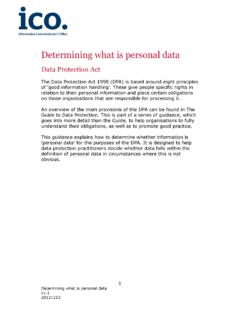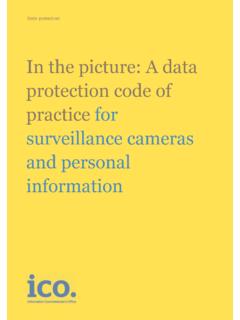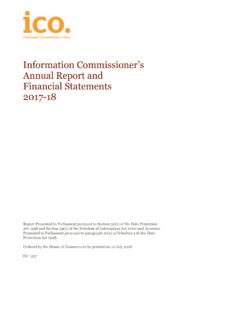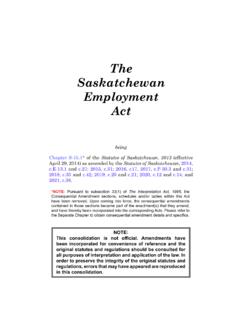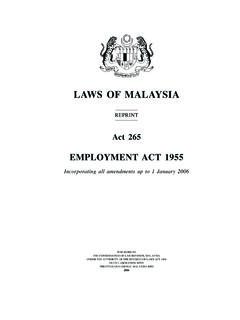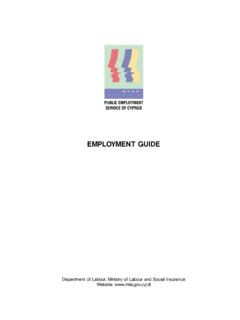Transcription of The employment practices code - Home | ICO
1 Data protection The employment practices code Contents 3. Contents About the code 4 Discipline, grievance and dismissal 54. Outsourcing data processing 55. Managing data protection 11 Retention of records 56. Good practice recommendations 11. Part 3: Monitoring at work 58. Part 1: Recruitment and selection 14 About Part 3 of the code 58. About Part 1 of the code 14 Good practice recommendations 65. Good practice recommendations 16 The general approach to monitoring 65. Advertising 16 Monitoring electronic communications 69. Applications 16 Video and audio monitoring 73. Verification 20 Covert monitoring 74. Short-listing 21 In-vehicle monitoring 76. Interviews 22 Monitoring through information Pre- employment vetting 23 from third parties 76. Retention of recruitment records 25. Part 4: Information about workers' health 79.
2 Part 2: employment records 28 About Part 4 of the code 79. About Part 2 of the code 28 Good practice recommendations 85. Good practice recommendations 31 Information about workers' health 85. Collecting and keeping general Occupational health schemes 88. records 32 Information from medical Security 34 examination and testing 89. Sickness and injury records 36 Information from drug and alcohol testing 92. Pension and insurance schemes 38. Information from generic testing 94. Equal opportunities monitoring 40. Marketing 41. Fraud detection 42. Workers' access to information about themselves 43. References 46. Disclosure requests 47. Publication and other disclosures 50. Merger, aquisition, and business re-organisation 52. 4 About the code About the code Our aim This code is intended to help employers comply with the Data Protection Act and to encourage them to adopt good practice.
3 The code aims to strike a balance between the legitimate expectations of workers that personal information about them will be handled properly and the legitimate interests of employers in deciding how best, within the law, to run their own businesses. It does not impose new legal obligations. Who is the code for? The employment practices Data Protection code deals with the impact of data protection laws on the employment relationship. It covers such issues as the obtaining of information about workers, the retention of records, access to records and disclosure of them. Not every aspect of the code will be relevant to every organisation . this will vary according to size and the nature of its business. Some of the issues addressed may arise only rarely particularly for small businesses. Here the code is intended to serve as a reference document to be called on when necessary.
4 The benefits of the code The Data Protection Act 1998 places responsibilities on any organisation to process personal information that it holds in a fair and proper way. Failure to do so can ultimately lead to a criminal offence being committed. The effect of the Act on how an organisation processes information on its workers is generally straightforward. But in some areas it can be complex and difficult to understand, especially if your organisation has only limited experience of dealing with data protection issues. The code therefore covers the points you need to check, and what action, if any, you may need to take. Following the code should produce other benefits in terms of relationships with your workers, compliance with other legislation and efficiencies in storing and managing information.
5 About the code 5. Following the code will: i ncrease trust in the workplace there will be transparency about information held on individuals, thus helping to create an open atmosphere where workers have trust and confidence in employment practices . e ncourage good housekeeping following the code encourages organisations to dispose of out-of-date information, freeing up both physical and computerised filing systems and making valuable information easier to find. p rotect organisations from legal action adhering to the code will help employers to protect themselves from challenges against their data protection practices . e ncourage workers to treat customers' personal data with respect following the code will create a general level of awareness of personal data issues, helping to ensure that information about customers is treated properly.
6 H elp organisations to meet other legal requirements the code is intended to be consistent with other legislation such as the Human Rights Act 1998 and the Regulation of Investigatory Powers Act 2000 (RIPA). a ssist global businesses to adopt policies and practices which are consistent with similar legislation in other countries . the code is produced in the light of EC Directive 95/46/EC and ought to be in line with data protection law in other European Union member states. h elp to prevent the illicit use of information by workers . informing them of the principles of data protection, and the consequences of not complying with the Act, should discourage them from misusing information held by the organisation. What is the legal status of the code ? The code has been issued by the Information Commissioner under section 51 of the Data Protection Act.
7 This requires him to promote the following of good practice, including compliance with the Act's requirements, by data controllers and empowers him, after consultation, to prepare codes of Practice giving guidance on good practice. The basic legal requirement on each employer is to comply with the Act itself. The code is designed to help. It sets out the Information Commissioner's recommendations as to how the legal requirements of the Act can be met. Employers may have alternative ways of meeting these requirements but if they do nothing they risk breaking the law. 6 About the code Any enforcement action would be based on a failure to meet the requirements of the Act itself. However, relevant parts of the code are likely to be cited by the Commissioner in connection with any enforcement action that arises in relation to the processing of personal information in the employment context.
8 Who does data protection cover in the workplace? The code is concerned with information that employers might collect and keep on any individual who might wish to work, work, or have worked for them. In the code the term worker' includes: applicants (successful and unsuccessful). former applicants (successful and unsuccessful). employees (current and former). agency staff (current and former). casual staff (current and former). contract staff (current and former). Some of this code will also apply to others in the workplace, such as volunteers and those on work experience placements. What information is covered by the code ? Information about individuals, that is kept by an organisation on computer in the employment context, will fall within the scope of the Data Protection Act and therefore, within the scope of this code However, information that is kept in simple manual files will often fall outside the Act.
9 Where information falls outside the Act, this code can do no more than offer advice on good information handling practice. Personal information The code is concerned with personal information'. That is, information which: is about a living person and affects that person's privacy (whether in his/her personal or family life, business or professional capacity) in the sense that the information has the person as its focus or is otherwise biographical in nature, and identifies a person, whether by itself, or together with other information in the organisation's possession or that is likely to come into its possession. About the code 7. This means that automated and computerised personal information kept about workers by employers is covered by the Act. It also covers personal information put on paper or microfiche and held in any relevant filing system'.
10 In addition, information recorded with the intention that it will be put in a relevant filing system or held on computer is covered. Only a well structured manual system will qualify as a relevant filing system. This means that the system must amount to more than a bundle of documents about each worker filed in date order. There must be some sort of system to guide a searcher to where specific information about a named worker can be found readily. This might take the form of topic dividers within individually named personnel files or name dividers within a file on a particular topic, such as Training Applications'. Processing The Act applies to personal information that is subject to processing'. For the purposes of the Act, the term processing'. applies to a comprehensive range of activities. It includes the initial obtaining of personal information, the retention and use of it, access and disclosure and final disposal.
